Texas foster care redesign: Initial insights into foster care reform.
 In 2013, the Texas Institute for Child & Family Wellbeing (TXICFW) conducted a process evaluation on the redesign of the Texas foster care system. This new report, funded by the Texas DFPS, presents findings from the process evaluation.
In 2013, the Texas Institute for Child & Family Wellbeing (TXICFW) conducted a process evaluation on the redesign of the Texas foster care system. This new report, funded by the Texas DFPS, presents findings from the process evaluation.
Foster care redesign is the result of a multi-year process involving over 3,000 stakeholders, numerous foster care model examples, and a detailed analysis of data on how children fare in Texas foster care. This new way of providing foster care services relies on a single contractor to implement its model within various geographic areas. The model aims to find foster homes or other living arrangements for children in state care and provide them, and if necessary, their families a full continuum of services.
The goals of the redesign are to:
- Keep children and youth closer to home and connected to their communities and siblings.
- Improve the quality of care and outcomes for children and youth.
- Reduce the number of times children move between foster homes.
Findings from both study components suggest the redesign pilot has experienced the initial implementation issues typical of large-scale system change. However, people in the region are committed to making the redesign work. Respondents identified many challenges to a successful redesign, but expressed positive feelings about the potential changes the redesign can have on the foster care system.
Read the report:
Texas foster care redesign: Initial insights into foster care reform
Schwab, J., Faulkner, M., Landuyt, M., Fong, R., Scott, J., Gerlach, B. & Ryan, T. (2014). Texas foster care redesign: Initial insights into foster care reform. Texas Department of Family and Protective Services & Casey Family Programs. Austin, TX: The University of Texas at Austin, Child and Family Research Institute.
